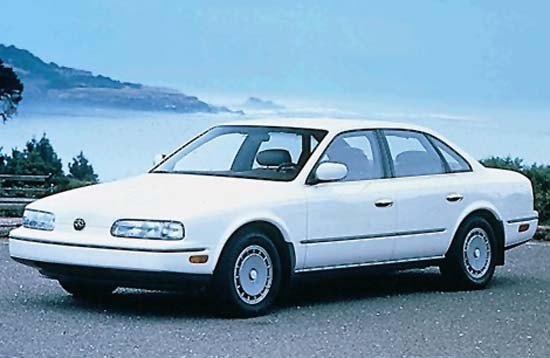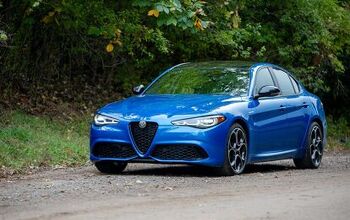90s Japanese Luxury Car Purchase Dilemma: Q45, LS 400, or RL?

Since my daily-driver ’92 Civic is about to become a much less civilized car (plus it’s finally made the transition from “somewhat rough” to “total beater,” I need to start shopping for another DD very soon. Since I’ve developed a fascination with Japanese luxury cars of the 1990s (the era before the Japanese Big Three de- Yakuza-ized the souls of their American flagships and started out-German-ing the Germans), I’ve decided it’s time I owned one. The question is: which one?
Ah, the LS 400. Plenty of them were eaten by The Crusher during the Cash For Clunkers era, but most of these big, dignified V8 sedans are still on the road today. It’s easy to picture a mid-level Nagoya loanshark making his rounds in a discreet gunmetal-gray Celsior, maybe with a couple of kneecap-busting heavies riding in the very comfortable back seat. You might not need to send your muscle out of the car to encourage timely payments from your clients, but the understated menace of the Celsior lets everyone know the option is there. Sadly, Toyota must have ditched their Yakuza consultants from their focus groups by 2000, because the LS 430 and successors were just very comfortable appliances. You can pick up a very nice LS 400 for about five grand, though it costs a bit more if you need to go VIP style with one.
The Infiniti Q45 is a much goofier car than the LS 400. Its V8 has about 40 horses over the early LS 400’s engine and Q45 buyers got variable valve timing, active suspension, and four-wheel steering. The reliability wasn’t quite up to LS 400 standards (watch out for those timing chain guide failures!) but there’s a huge helping of that Japanese love of technology for its own sake that’s sadly lacking in most of this century’s Japanese vehicles. The average age of a Q45 owner tends to be much lower than that of LS 400 owners, and the Q45 didn’t hold its value quite as well, which means most of them have had the crap beaten out of them by now. In addition, I must have a 1990-1993 model, with the strange grille-less face. I might not be able to find a low-mile, solid example, but we’ll see. I’m also tempted by the J30, but it’s just not as extreme as the early Q45.

Murilee Martin is the pen name of Phil Greden, a writer who has lived in Minnesota, California, Georgia and (now) Colorado. He has toiled at copywriting, technical writing, junkmail writing, fiction writing and now automotive writing. He has owned many terrible vehicles and some good ones. He spends a great deal of time in self-service junkyards. These days, he writes for publications including Autoweek, Autoblog, Hagerty, The Truth About Cars and Capital One.
More by Murilee Martin
Latest Car Reviews
Read moreLatest Product Reviews
Read moreRecent Comments
- Theflyersfan OK, I'm going to stretch the words "positive change" to the breaking point here, but there might be some positive change going on with the beaver grille here. This picture was at Car and Driver. You'll notice that the grille now dives into a larger lower air intake instead of really standing out in a sea of plastic. In darker colors like this blue, it somewhat conceals the absolute obscene amount of real estate this unneeded monstrosity of a failed styling attempt takes up. The Euro front plate might be hiding some sins as well. You be the judge.
- Theflyersfan I know given the body style they'll sell dozens, but for those of us who grew up wanting a nice Prelude Si with 4WS but our student budgets said no way, it'd be interesting to see if Honda can persuade GenX-ers to open their wallets for one. Civic Type-R powertrain in a coupe body style? Mild hybrid if they have to? The holy grail will still be if Honda gives the ultimate middle finger towards all things EV and hybrid, hides a few engineers in the basement away from spy cameras and leaks, comes up with a limited run of 9,000 rpm engines and gives us the last gasp of the S2000 once again. A send off to remind us of when once they screamed before everything sounds like a whirring appliance.
- Jeff Nice concept car. One can only dream.
- Funky D The problem is not exclusively the cost of the vehicle. The problem is that there are too few use cases for BEVs that couldn't be done by a plug-in hybrid, with the latter having the ability to do long-range trips without requiring lengthy recharging and being better able to function in really cold climates.In our particular case, a plug-in hybrid would run in all electric mode for the vast majority of the miles we would drive on a regular basis. It would also charge faster and the battery replacement should be less expensive than its BEV counterpart.So the answer for me is a polite, but firm NO.
- 3SpeedAutomatic 2012 Ford Escape V6 FWD at 147k miles:Just went thru a heavy maintenance cycle: full brake job with rotors and drums, replace top & bottom radiator hoses, radiator flush, transmission flush, replace valve cover gaskets (still leaks oil, but not as bad as before), & fan belt. Also, #4 fuel injector locked up. About $4.5k spread over 19 months. Sole means of transportation, so don't mind spending the money for reliability. Was going to replace prior to the above maintenance cycle, but COVID screwed up the market ( $4k markup over sticker including $400 for nitrogen in the tires), so bit the bullet. Now serious about replacing, but waiting for used and/or new car prices to fall a bit more. Have my eye on a particular SUV. Last I checked, had a $2.5k discount with great interest rate (better than my CU) for financing. Will keep on driving Escape as long as A/C works. 🚗🚗🚗


































Comments
Join the conversation
The Q is a sweet ride on the cheap. Fast, handles surprisingly well (get Tokico Blue shocks to really improve the cornering for very reasonable money) and is very comfy. Downsides? Not fun to fix, the timing chains NEED to be addressed, the trannies are fragile at high miles, the driveshafts wear out and need new rubber bushings, and you should avoid the active suspension/four wheel steering models at all costs if you want to stay out of bankruptcy. It also sucks fuel at a rather alarming rate; mid teens in the city is good, YMMV, I got between 8.5 and 12 mpg in downtown Montreal with mine, but a decent 28-30mpg on the highway (Imperial units). An 85 litre tank made for a long cruising range but a minor heart attack at every fillup. It felt more sprightly and fun than a comparable BMW or Merc of that era, if not as well screwed together. My point of comparison was a 92 420SE W140 which felt like the proverbial rolling bank vault. I drove an early LS; my impression was extremely boring and slow for a V8, but surprisingly tight considering how well used and abused that example was. The Q is the fun choice by far, but it isn't the best built. 1990-93 is the best Q motor wise. That was the VH45 series which was seriously overbuilt, aside from the chain tensioners. They had sodium filled valves, polished conrods and crank, much stronger internals, and a higher output than the later cheaper-to-build 4.1L. It was a cost-no-object sort of engine that was replaced by a bean-counter friendly V8 in the later models. I miss the fun of the Q, but I don't miss the fuel bill or the many repairs I had to do to it (or that nagging driveline vibration that wasn't getting any better..).
Hey hey hey! Zillion postings. I am a new member commenting on CC, and my wife and I have had nothing but Lexus 8s for the last 17 years. Does that make us car snobs?